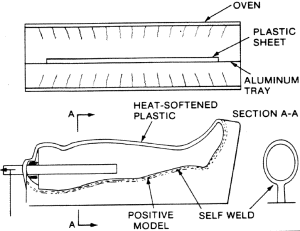42 Drape Forming
Drape forming is used to fabricate, sockets, flexible inner sockets, orthoses, and other devices that have a seam or are open at one end. It may be used with various types and thicknesses of thermoplastic sheets. Common plastics used in P&O are LDPE (low density polyethylene), HDPE (high density polyethylene), PP (polypropylene), Copolymer, Surlyn, Proflex with Silicone, Subortholene, PETG, Kydex, as well as foams, such as Pelite and Plastizote.
PPE
- Always wear dry gloves and forearm protection while working with hot materials.
- Close toe shoes should be worn in all lab areas.
General Technique Tips
Preparation
- Turn on oven and check oven temperature: Melting temperatures vary by type of plastic. The manufacturer’s recommended thermoforming temperature for each plastic (noted in the SDS) is recorded in our “thermoforming” notebook in the black cabinet. Check for the appropriate temperature and set the oven temperature to match. Beware that overheating plastic may cause some plastics to release fumes that may be harmful.
- Turn on/check vacuum pressure at the gauge located on the center post of the thermoforming station: for polypropylene, polyethylene, PETG and Kydex, a low vacuum of about 20 in. Hg. is satisfactory
- Set up the positive model:
- securely position it horizontally in the vacuum pipe
- fill gaps between the top of the model and the vacuum pipe.
- place nylon over the model avoiding wrinkles inside trimlines. securely attach the nylon to the pipe.
- cover the pipe with 3/16″ aliplast and secure in place with black tape. Ensure that there are no areas for air to leak between the vacuum pipe and the top edges of the aliplast.
- Ensure the work area is clear of obstacles.
- Locate and ensure you are familiar with the operation of the vacuum lever.
- Have additional tools accessible and ready for use, e.g., scissors, utility blade.
- Consider potential problems:
- Loss of suction – always have clay available to plug holes.
- No suction – always check that there are no areas for the air to leak between the vacuum pipe and the top edges of the aliplast.

Thermoform
- Set up the model
- Place the pipe of the model in the vacuum pipe. Position the model so that the toes are pointed downward.
- Tape aliplast around the end of the vacuum pipe. This provides an area for the plastic to seal around the pipe and eases removal after thermoforming.
- Place two layers of stockinette over the model ensuring no wrinkles at areas inside the trimlines.
- Cut plastic
- Measure longitudinal length, from toe over the heel to the pipe – add 3 inches
- Measure the circumference at the largest part of the calf and around the instep – add 1 inch
- Place plastic in oven
- Double check vacuum
- Predict potential problems
- Prep with your partner
- Ensure scissors and clay are easily accessible
- After the plastic has turned clear, pull it out of the oven and drape over the model as illustrated.
- Grasp plastic at the ankle and gently pull toward the heel to avoid wrinkles at ankle.
- Grasp plastic at proximal end and secure smoothly to the pipe. Avoid bunching.
- Seal plastic on bottom surface of model
- Do not touch the plastic within the trimlines or your glove marks will imprint the plastic. This is the finished product, unlike the test socket.
- Slowly turn on the vacuum while securely holding the plastic to pipe (avoid loss of vacuum).
- Cut off excess plastic about 2cm from seam.
Vacuum Hold Time: When to turn off vacuum?
- Many have experienced AFO warpage, or spread, when plastic is cut off and removed from vacuum too soon. Spread is particularly relevant for open-shaped (non-circumferential) devices such as AFOs and TLSOs which are also typically fabricated from semi-crystalline materials more susceptible to shrinkage. There are several ‘rules of thumb’ used in practice. For example, Lunsford notes that it is not uncommon to maintain vacuum for up to one hour . However, a general rule is to leave the vacuum on at least twice the time it took to heat or once all areas of the plastic are cool to touch.
After thermoforming
- Store all gloves and tools properly.
- Turn off the oven and the compressor.
- Do not use anything but a dry cloth to wipe off the oven tray
Additional resources
Draping Polypropylene AFO with compcore
Fabrication Of Microcell Puff Innerboots For Use In Pediatric AFO’s
Introduction to Clinical Thermoforming 1 by Gary Bedard
